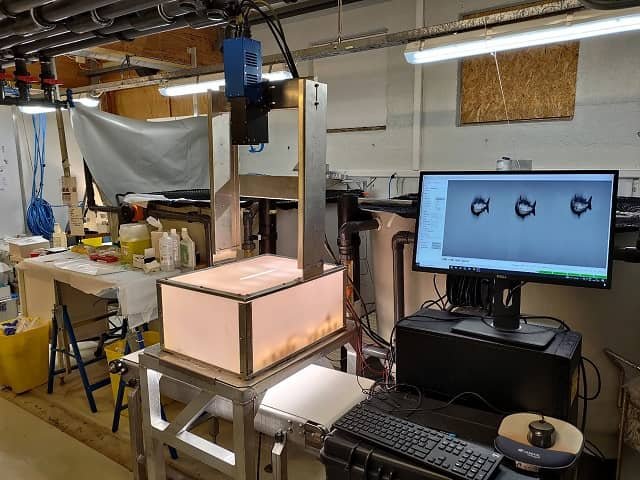
In aquaculture, morphological injuries are considered operational indicators of welfare. However, the high number of fish in a single production system makes recording these injuries a challenging task.
Operational welfare indicators are often manually scored by human observers based on pre-approved scoring schemes. However, this process can be laborious and prone to subjectivity and errors.
A team of scientists from Nofima AS and the Norwegian University of Life Sciences evaluated the use of a hyperspectral imaging system to quantify the presence and severity of external hemorrhages in Atlantic salmon, focusing on dorsal fins as a proof-of-concept for operational welfare indicators.
Physical injuries as operational welfare indicators
Physical injuries are well-established operational welfare indicators for aquatic species. These injuries may include hemorrhages, such as dorsal fin hemorrhage, which is a common lesion throughout the salmon production cycle.
Hemorrhage is indicative of an active injury that may be directly related to ongoing welfare issues in the rearing system. Therefore, the accurate identification of dorsal fin hemorrhage is a valuable tool for fish welfare management under the FISHWELL scheme.
In salmon industry operations, fin injuries are grouped into a mixed-type operational welfare indicator called “active fin damage.”
Hyperspectral images
“Hyperspectral imaging is a spectroscopic technique that captures the reflection of light in narrow wavelength bands with a level of detail that surpasses human visual perception and traditional cameras,” the scientists define.
They also highlight that “hyperspectral cameras produce images in which each pixel contains a graph showing the composition of light registered by that pixel in a range of the electromagnetic spectrum.”
Currently, hyperspectral images are used in various applications, including quality and food safety assessments, medical diagnoses, and measurements of vegetation and crop parameters in forestry and agriculture.
In the fishing industry, hyperspectral images have been successfully used to measure different oxidative states of hemoglobin in Atlantic cod fillets.
Study methodology
The scientists employed two inexperienced observers to manually audit dorsal fin lesions in 234 Atlantic salmon post-smolts following a standardized protocol that assessed fin erosion and also classified the lesion as active/cured.
Subsequently, they took images of the same fish using a hyperspectral camera system, and the visually graded manual assessments were compared with hyperspectral images of the same fin.
As part of their methodology, the scientists processed hyperspectral images to segment the dorsal fin of each fish and quantified the presence of blood in the tissue by analyzing spectral information, resulting in a fin hemorrhage index.
Hyperspectral imaging platform
The study describes an innovative high-performance hyperspectral imaging platform to quantify the presence and severity of dorsal fin hemorrhage as an operational welfare indicator for Atlantic salmon.
“The hyperspectral imaging platform was robust in detecting bleeding in the fins and can help classify active wounds more accurately than human observers,” report the scientists.
According to the study’s results, hyperspectral images have the potential to enhance welfare audits in salmon aquaculture.
The scientists highlight that “The data also suggest that the hyperspectral camera can detect hemorrhages that are not easily visible to the human eye.”
Conclusion
“Automated hyperspectral measurement of hemorrhage in the dorsal fin, focusing on hemoglobin, is a highly accurate method for distinguishing between active and cured or intact dorsal fins. The total hemoglobin abundance per unit fin area shows some agreement with manual human scoring of operational welfare indicators,” the scientists concluded.
The scientists recommend conducting further tests and validations to integrate these tools into existing welfare audit programs, as the automated approach includes higher sensitivity, precision, and performance, in addition to providing quantitative data for researchers or salmon farm management.
The study was funded by the Research Council of Norway through a grant to Nofima for the PrecisionVision project, as well as the Vision2Precision, DigitalAqua, and SmoltFieldGenetics projects of Nofima.
Reference (open access)
Lindberg S-K, Durland E, Heia K, Noble C, Alvestad R and Difford GF (2023) Digital scoring of welfare traits in Atlantic salmon (Salmo salar L.) – a proof of concept study quantifying dorsal fin haemorrhaging via hyperspectral imaging. Front. Anim. Sci. 4:1162384. doi: 10.3389/fanim.2023.1162384

